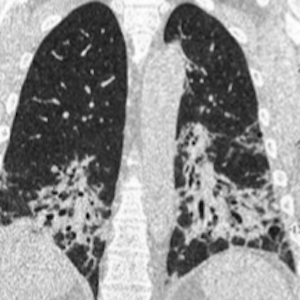Diagnosis and treatment of interstitial lung disease related to systemic autoimmune myopathies: a narrative review

Accepted: 5 April 2023
All claims expressed in this article are solely those of the authors and do not necessarily represent those of their affiliated organizations, or those of the publisher, the editors and the reviewers. Any product that may be evaluated in this article or claim that may be made by its manufacturer is not guaranteed or endorsed by the publisher.
Authors
Systemic autoimmune myopathies (SAMs) are rare diseases that lead to muscle inflammation and may be associated with a variety of systemic manifestations. Although there is great heterogeneity in the spectrum of extra-muscular involvement in SAMs, interstitial lung disease (ILD) is the most frequent lung manifestation. SAM-related ILD (SAM-ILD) presents significant variations according to geographic location and temporal trends and is associated with increased morbidity and mortality. Several myositis autoantibodies have been discovered over the last decades, including antibodies targeting aminoacyl-tRNA synthetase enzymes, which are associated with a variable risk of developing ILD and a myriad of other clinical features. In this review, the most relevant topics regarding clinical manifestations, risk factors, diagnostic tests, autoantibodies, treatment, and prognosis of SAM-ILD are highlighted. We searched PubMed for relevant articles published in English, Portuguese, or Spanish from January 2002 to September 2022. The most common SAM-ILD patterns are nonspecific interstitial pneumonia and organizing pneumonia. The combination of clinical, functional, laboratory, and tomographic features is usually sufficient for diagnostic confirmation, without the need for additional invasive methods. Glucocorticoids remain the first-line treatment for SAM-ILD, although other traditional immunosuppressants, such as azathioprine, mycophenolate, and cyclophosphamide have demonstrated some efficacy and, therefore, have an important role as steroid-sparing agents.
Supporting Agencies
This work was supported by Brazilian Society of RheumatologyHow to Cite

This work is licensed under a Creative Commons Attribution-NonCommercial 4.0 International License.
Authors who publish with this journal agree to the following terms:
- Authors retain copyright and grant the journal right of first publication with the work simultaneously licensed under a Creative Commons Attribution License that allows others to share the work with an acknowledgement of the work's authorship and initial publication in this journal.
- Authors are able to enter into separate, additional contractual arrangements for the non-exclusive distribution of the journal's published version of the work (e.g., post it to an institutional repository or publish it in a book), with an acknowledgement of its initial publication in this journal.
- Authors are permitted and encouraged to post their work online (e.g., in institutional repositories or on their website) prior to and during the submission process, as it can lead to productive exchanges, as well as earlier and greater citation of published work.
Similar Articles
- A. Cauli, G. Dessole, P.P. Nurchis, A. Vacca, A. Mameli, P. Garau, R. Pala, G. Passiu, A. Mathieu, The role of HLA-B27 molecules in the pathogenesis of ankylosing spondylitis , Reumatismo: Vol. 54 No. 3 (2002)
- G. Ceccarelli, Archeology in Medicine: Digging up into the tophi of Popes, Dukes and Kings , Reumatismo: Vol. 55 No. 2 (2003)
- P. Lazzarin, G. Cesaro, S. Puggina, B. Perin, L. Cremonini, G. Padovani, P. Sfriso, M.T. Sartori, Femoral and humeral head osteonecrosis in a patient with hypofibrinolisis and hyperhomocysteinemia. A case report and a review of the literature , Reumatismo: Vol. 56 No. 3 (2004)
- C. Botsios, P. Ostuni, S. Todesco, Incidence and management of infusion reactions to infliximab in 186 italian patient’s with rheumatoid arthritis: the Padua experience , Reumatismo: Vol. 57 No. 1 (2005)
- U. Fiocco, S. Bombardieri, Differences in pharmacology of tumor necrosis factor (TNF) antagonists , Reumatismo: Vol. 57 No. s4 (2005)
- B. Raffeiner, C. Botsios, F. Ometto, L. Bernardi, A. Montante, P. Sfriso, S. Todesco, L. Punzi, TNFα blockers and infectious risk in rheumatoid arthritis , Reumatismo: Vol. 61 No. 3 (2009)
- S. Cuffaro, T. Del Ross, M. Tonello, A. Bontadi, S. Olivieri, E. Salvan, A. Ruffatti, L. Punzi, Confirmation of antiphospholipid antibody positivity: a year’s results in a cohort of 113 patients , Reumatismo: Vol. 62 No. 1 (2010)
- E. Conticini, A. Negro, L. Magnani, R. Ugolini, B. Atienza-Mateo, B. Frediani, C. Salvarani, Gitelman syndrome associated with chondrocalcinosis and severe neuropathy: a novel heterozygous mutation in SLC12A3 gene , Reumatismo: Vol. 72 No. 1 (2020)
- B. Maranini, G. Ciancio, R. Cultrera, M. Govoni, Herpes zoster infection following mRNA COVID-19 vaccine in a patient with ankylosing spondylitis , Reumatismo: Vol. 73 No. 3 (2021)
- A.M. Treichel, D.X. Zheng, G.C. Ranasinghe, A.S. Zeft, W.F. Bergfeld, C.B. Bayart, Eosinophilic fasciitis in a young male auto mechanic exposed to organic solvents , Reumatismo: Vol. 75 No. 3 (2023)
<< < 54 55 56 57 58 59 60 61 62 63 > >>
You may also start an advanced similarity search for this article.

 https://doi.org/10.4081/reumatismo.2023.1571
https://doi.org/10.4081/reumatismo.2023.1571




